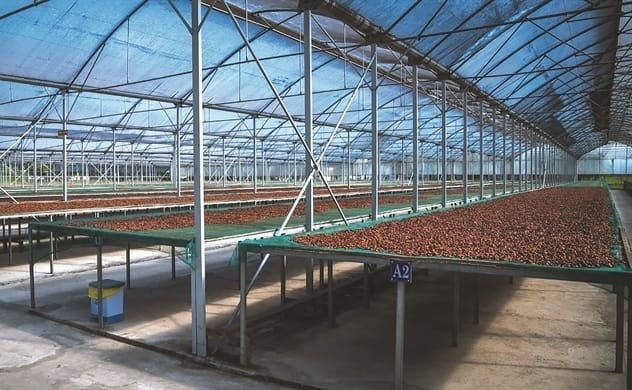
In December 2021, Puratos Grand-Place Vietnam achieved a remarkable milestone by obtaining the Carbon Neutral Certificate for its entire operations, encompassing three factories and seven offices.
More than a year later, the firm received another significant recognition by obtaining a carbon-neutral certificate for its 60DAYS chocolate product. The review had the opportunity to discuss this remarkable sustainable development journey with Mr. Gricha Safarian, the founder of Grand Place Holdings and CEO of Puratos Grand-Place.
What was the timeline from ideation to reaching the carbon-neutral target, and how did the company allocate its resources for this endeavor?
The investment for the certificate takes approximately 1% of our revenue, which is not significant when compared to the overall profit of the company, ranging from 6% to 7%. We successfully obtained the Carbon Neutral Certificate at the company level first in 2021.
The certification process offers three levels: Scope 1 for individual factories, Scope 2 for the company-wide level which we attained by the end of 2021, and Scope 3 for the product level, which includes the certification for our 60DAYS chocolate, which we achieved in January 2023.
It took us four years and 642,000 euros to succeed in Scope 2, and another three years to attain the Scope 3 certificate. The COVID-19 pandemic posed challenges, necessitating a shift in priorities to focus on survival during those difficult times.
Nevertheless, I am immensely proud of my team’s unwavering commitment to the goal of carbon neutrality, leading to the successful acquisition of the certificate. It’s essential to note that the certificate requires annual renewal and is not permanent; failure to maintain it will result in expiration after a year.
We used to collaborate with an NGO and were provided with an estimate of 2.5 tonnes of carbon emissions per ton of cocoa. However, upon closer examination, we discovered that our actual emissions were substantially higher, ranging from 6 to 7 tons.
As a result, we are dedicated to improving the accuracy of our emissions measurement and actively working towards reducing our carbon footprint. This includes purchasing additional carbon certificates and implementing measures to effectively decrease our emissions.
In the future, I hope the Government will enact a law regarding the procurement of clean energy. If we have the opportunity to purchase wind power and green electricity, it would reduce our reliance on carbon certificates. While I recognize the potential benefits of carbon certificates, I am wary of the possibility of abuse. Additionally, we are considering acquiring land in Indochina to cultivate cocoa trees, which would enable us to issue our own carbon certificates in the future.
Is achieving net zero at the company quicker and easier due to its small size?
Indeed, it is true that obtaining a Carbon Neutral Certificate is generally easier for small to medium-sized companies compared to larger ones. This is mainly due to the simpler calculations involved at a smaller scale. However, the overall process remains the same for all companies regardless of size.
Typically, there are two primary methods to offset carbon emissions: purchasing carbon certificates and implementing concrete actions to reduce emissions. It’s essential to strike a balance between the two approaches. Currently, there are no specific laws regulating the maximum percentage of carbon offset that can be achieved through certificates alone.
Unfortunately, some organizations opt to compensate solely by purchasing carbon certificates without taking substantial action to reduce their actual carbon emissions. While this may grant them the certificate, it does not contribute significantly to environmental improvements. In the long run, such companies might bear the cost as they may face reputational issues and possible environmental consequences.
To create a meaningful and sustainable impact, it is crucial for companies to focus on both purchasing carbon certificates and actively taking measures to reduce their carbon footprint. A genuine commitment to sustainability and tangible efforts in emission reduction will not only help in obtaining the certificate but also contribute positively to the environment and society.
 |
| Mr. Gricha Safarian, the founder of Grand Place Holdings and CEO of Puratos Grand-Place. |
What attributes enable Puratos Grand-Place to outpace other Puratos entities globally?
I consider myself very fortunate to share a close and direct relationship with the Group’s owner. We both have a deep passion for cocoa, which led us to start a joint venture about 10 years ago. Over time, I had numerous conversations with him, gradually influencing him toward a path of sustainability. He holds significant authority, and his decisions carry weight across the organization.
However, embracing sustainability has not been without its challenges. Along this journey, I’ve encountered opposition from some individuals within the Group, including the person in charge of cocoa purchasing. Their focus was on negotiating the lowest price possible, while our commitment to Cacao Trace compelled us to seek the highest possible price for the farmers. This created conflicts, and after a year of contention, I decided to escalate the matter to the Board of Directors, urging them to revise the Key Performance Indicators (KPIs) to recognize and reward sustainable practices.
The adjustment to KPIs brought about a positive change, leading to the person responsible for cocoa procurement becoming content with the new approach. However, this experience has taught me a valuable lesson applicable to any company aiming for sustainability.
Such a transformation requires understanding and acknowledging that it may be challenging for some individuals within the organization. To succeed, it is essential to anticipate these challenges and establish appropriate KPIs, as clinging to old-style KPIs can hinder progress when pursuing new and sustainable business practices.
In your view, which is relatively easier to achieve zero carbon: a specific product or an entire manufacturing plant? Additionally, is there a discrepancy in attaining this level of sustainability among different products, such as chocolate versus milk or beer?
Achieving zero carbon emissions with certain products can indeed be more challenging. For these products, emissions are calculated throughout the entire supply chain, starting from raw material collection and transportation to the factory, up to packaging disposal in the consumer market, both in Vietnam and even in the countries the products are used.
While the journey remains consistent for all products, specific supply chains may require unique calculations and approaches. Take beer, for example, where excess water usage poses an additional challenge, leading to emissions related to water transportation. However, in our supply chain, the primary emissions lie elsewhere.
Regardless of the product, the path to sustainability is voluntary at the moment, as there are no legal requirements in Vietnam mandating carbon neutrality. The decision to pursue this path rests with individual managers. Although it may involve higher costs, such an investment can result in increased business, more customers, and a better overall image for the company.
In the realm of sustainability, all businesses face similar challenges. It demands courage to make a resolute decision and continue the journey, even as it becomes progressively more arduous. The commitment to sustainability should be ongoing and steadfast.
Puratos Group has set a target for all its entities to become carbon neutral by 2025 for our operations, water-balanced by 2030, and Zero-waste-to-landfill, worldwide, by 2030. This serves as a Key Performance Indicator (KPI) for the entire Group, promoting unified efforts toward a sustainable future.
Can other agricultural exports replicate your company’s process to achieve net-zero emissions, in your opinion?
Certainly, other agricultural exports can follow a similar path to achieve net-zero emissions. Let’s consider the example of level 3 sustainability for coffee. Unlike chocolate, coffee beans require fewer processing steps since they only need to be harvested and roasted.
On the other hand, cocoa beans for chocolate production go through additional steps like fermentation, roasting, grinding into cocoa powder, extraction of cocoa butter, and mixing with various ingredients. These steps not only make the process lengthier but also introduce additional raw materials like sugar and milk, which contribute to the carbon emissions that need to be considered.
Although achieving level 3 sustainability for coffee is not without its challenges, it can be considered relatively simpler than chocolate due to its streamlined processing. Even products like bananas are easier in this regard, as their carbon calculation primarily revolves around agricultural and transportation processes, without requiring fermentation or roasting.
An essential point for sustainability is to increase production in the country where the crop is grown. Companies like ours, which control the entire supply chain in the cocoa-producing country, have a competitive advantage and a compelling narrative.
However, this approach also means that any hiccup at any stage can disrupt the entire process. For instance, our 60DAYS chocolates, which have a shorter production time, present higher stakes and less room for error compared to other chocolates that may take up to 15 months to make.
Opting for vertical integration is indeed a powerful strategy, but it’s also the most challenging to execute. Despite the difficulties, we deliberately chose this path, as it offered fewer competitors and allowed us to have greater control over the sustainability aspects throughout the supply chain, from plantations to the final products.





